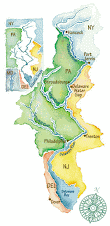
This is an image of the Lehigh River watershed in eastern Pennsylvania. The river runs between Lehigh County on the west and Northampton County on the east. The name "Lehigh" is an aanglicized version of a Lenni Lenape name. Many of the creeks also carry names given by this tribe who are part of the Algonquins.
The river flows south from Carbon County. I'm not sure where its source is. There used to be canals running alongside the river - some are still there - that were used to transport anthracite (hard coal) from those northern regions to the Delaware River, and down to Philadelphia. Mules used to pull the canal boats. You can take a canal boat ride, sponsored by the National Canal Museum in Easton. When I moved to Pennsylvania from Texas many years ago, one of the first outings I took was a nice float on the canal boat "Josiah White," pulled by hard-working mules.
Click on this link for information about the canals and boat rides:
http://www.canals.org/


